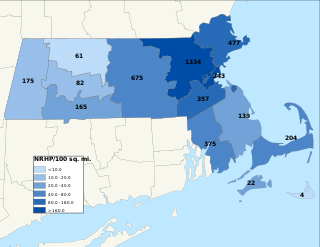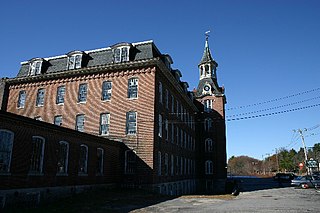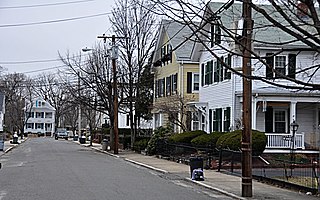
Devens is a regional enterprise zone and census-designated place in the towns of Ayer and Shirley and Harvard in the U.S. state of Massachusetts. It is the successor to Fort Devens, a military post that operated from 1917 to 1996. The population was 1,697 at the 2020 census, down from 1,840 in 2010.

City Point is an area in what is now The Hill neighborhood of the city of New Haven, Connecticut, located in the southwestern portion of the city. The City Point area was, when settled and through the 18th century, a relatively narrow peninsula extending south into New Haven Harbor, located where the West River empties into the harbor. Areas adjacent to the original peninsula have since been filled in, broadening its shoulders, and Interstate 95 has cut across it. The Oyster Point Historic District is a 26-acre (11 ha) historic district encompassing an area of relatively old buildings in City Point south of I-95.

Massachusetts Avenue is a major diagonal transverse road in Washington, D.C., and the Massachusetts Avenue Historic District is a historic district that includes part of it.

The National Register of Historic Places is a United States federal official list of places and sites considered worthy of preservation. In the state of Massachusetts, there are over 4,300 listings, representing about 5% of all NRHP listings nationwide and the second-most of any U.S. state, behind only New York. Listings appear in all 14 Massachusetts counties.

America's 11 Most Endangered Places or America's 11 Most Endangered Historic Places is a list of places in the United States that the National Trust for Historic Preservation considers the most endangered. It aims to inspire Americans to preserve examples of architectural and cultural heritage that could be "relegated to the dustbins of history" without intervention.

The Hampton Terrace Historic District, originally called the Lakewood Manor Subdivision, is a U.S. historic district located in the Old Seminole Heights neighborhood of Tampa, Florida. The district is roughly bounded by Hanna Avenue to the north, 15th Street to the east, Nebraska Avenue to the west, and Hillsborough Avenue to the south. Hampton Terrace Historic District was so designated by its inclusion in the National Register of Historic Places on January 27, 1999.

Linwood is a village with its own post office in the towns of Northbridge and Uxbridge, Massachusetts, United States.

Fort Logan H. Roots, commonly known as Fort Roots, is a former U.S. Army post in North Little Rock, Arkansas. It was named in honor of Brevet Lieutenant Colonel Logan Holt Roots, U.S. Volunteers, who served with distinction in the Western Theater of the American Civil War. It was established in 1892 and garrisoned from 1896 to 1913. After World War I, the post was transferred to the Public Health Service for use as a hospital, and in 1921, an Act of Congress authorized the establishment of a hospital for veterans.

The Ayer Main Street Historic District encompasses most of the historic central business district of Ayer, Massachusetts. It extends along Main Street between Park and Columbia Streets, and was mostly developed between 1872 and 1898 as a hub of railroad and roadway-based economic activity. The district was listed on the National Register of Historic Places in 1989.

Seton Hill Historic District is a historic district in Baltimore, Maryland. It was listed on the National Register of Historic Places in 1975.

The Old Ship Street Historic District is a historic district on both sides of Pleasant St. from Riverside Ave. to Park Street in Medford, Massachusetts. The district is based around shipyard established in 1803 by Thatcher Magoun, which operated into the 1870s. None of the industrial shipyard facilities have survived, leaving the area as a predominantly residential area. Most of the housing in the area derives from the first few decades of the shipyard's existence, resulting in a significant number of Federal and Greek Revival houses, built roughly between 1803 and 1855.

The Institutional District of Worcester, Massachusetts is an historic district encompassing a significant concentration of civic and municipal buildings north of the city's downtown area. It is centered on Lincoln Square and Wheaton Square, and includes properties on Main, Salisbury, and Tuckerman Streets. It includes the 1840s Worcester County Courthouse, the War Memorial and Memorial Auditorium, and the former Worcester Historical Society building at 39 Salisbury Street. The 1897 Worcester Art Museum is included in the district, as is the c. 1890 armory building at 44 Salisbury Street. The district was listed on the National Register of Historic Places in 1980.

Norwichtown is a historic neighborhood in the city of Norwich, Connecticut. It is generally the area immediately north of the Yantic River between I-395 and Route 169.

Alpheus C. Morse (1818-1893) was an American architect with offices in Providence, Rhode Island.

The Phoenix Historic Property Register is the official listing of the historic and prehistoric properties in the city of Phoenix, the capital and largest city, of the U.S. state of Arizona. The city's register includes most or all places in Phoenix listed on the National Register of Historic Places and many more of local significance.


















